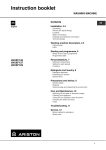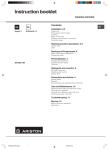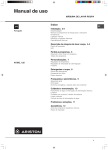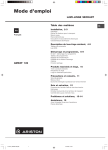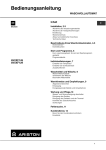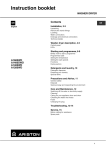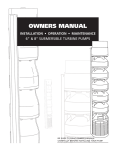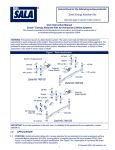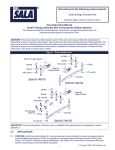Download Ariston AVXXL149 Washer User Manual
Transcript
Instruction booklet WASHING MACHINE GB Contents English Installation, 2-3 GB Unpacking Remove the transit fixings Levelling Water connections Drainage and electrical connections Technical details Washing machine description, 4-5 Control panel LEDs Starting and programmes, 6 Briefly: how to start a programme Programmes table AVXXL149 AVXXL129 AVXXL127 AVXXL109 AVXXL105 Personalisations, 7 Setting the temperature Setting the spin speeds Functions Detergents and laundry, 8 Detergent dispenser Preparing your laundry Special items Precautions and Advice, 9 General safety Disposal Saving energy and respecting the environment Care and Maintenance, 10 Switching off the water or electricity supply Cleaning Caring for your appliance door and drum Checking the water inlet hose Fuses Troubleshooting, 11 Service, 12 Before calling for assistance Spare parts 1 Installation GB ! Keep this instruction manual in a safe place for future reference. Should the appliance be sold, transferred or moved, make sure the instruction manual accompanies the washing machine to inform the new owner as to its operation and features. ! Read these instructions carefully: they contain vital information on installation, use and safety. Unpacking 1. Unpack the washing machine. 2. Check whether the washing machine has been damaged during transport. If this is the case, do not install it and contact your retailer. Remove the transit fixings IMPORTANT: Follow these instructions to remove the TWO transit fixings. Situated one either side of the rear panel, BOTH transit bolts MUST be removed before use. ! Failure to do so may cause damage to your machine. It is important the transit bolt and spacer come out intact (see pic). For safety, replace both plastic covers over the holes left by removing the two bolts. ! Packaging materials are not childrens toys. Levelling 1. Install the washing machine on a flat sturdy floor, without resting it up against walls, cabinets etc. 2. Compensate for any unevenness by tightening or loosening the adjustable front feet. The angle of inclination, measured according to the worktop must not exceed 2˚. Levelling your appliance correctly will provide it with stability and avoid any vibrations, noise and shifting during operation. If it is placed on a fitted or loose carpet, adjust the feet in such a way as to allow enough room for ventilation beneath the washing machine. Water connection Connecting the water inlet hose. Remember that this is a cold-fill machine. ! Check that seal is in place inside the hose end cap. 1. Use a crosshead screwdriver to remove the plastic cover. 2. Unscrew the bolt using a 13mm spanner. 3. STOP when 3 threads can be seen. 4. Hold, slide and pull to remove. 2 Before making the water connections to gas 3/4 thread, allow the water to run freely from the supply tap until it is perfectly clear. Screw the inlet end with the blue cap onto the cold water supply tap. Turn the taps on and check for leaks: tighten if necessary. ! Make sure there are no kinks or bends in the hose. ! The water pressure at the tap must be within the values indicated in the Technical details table (next page). ! If the water inlet hose is not long enough, contact a specialist store or an authorised serviceman. ! Always use new hoses. ! Check the water hose at least once a year, replace any that are cracked as worn hoses could split under water pressure. Drainage connections A A. Connect the drain hose, without kinking it, to a draining duct or a wall drain fixed at a height between 65 and 100cm from the floor. Dimensions 59.5cm wide 85cm high 60cm deep Capacity from 1 to 7kg Electric voltage 220/230 Volts 50Hz connections maximum absorbed power 1700W Water maximum pressure 1 MPa (10 bar) connections minimum pressure 0.05 MPa (0.5 bar) drum capacity 53 litres Spin Speed up to 1400 rpm - AVXXL149 up to 1200 rpm - AVXXL129, AVXXL127 up to 1000 rpm - AVXXL109, AVXXL105 Control programme 3 programmes temperature 60˚C according to run with a load of 7kg IEC456 directive Care and Maintenance This appliance is compliant with the following European Community Directives: - 72/23/CEE of 19/02/73 (Low Voltage) and subsequent amendments. - 89/336/CEE of 03/05/89 (Electromagnetic Compatibility) and subsequent amendments. Troubleshooting Service ! The washing machine should not be installed in an outdoor environment, not even when the area is sheltered, because it may be very dangerous to leave it exposed to rain and thunderstorms. ! When the washing machine is installed, the mains socket must be within easy reach and should be connected to a suitable electrical supply. ! Do not use extensions or multiple sockets. ! The power supply cable must never be bent or dangerously compressed. ! The power supply cable must only be replaced by an authorised serviceman. ! The company denies all liability if and when these norms are not respected. AVXXL149, AVXXL129, AVXXL127 AVXXL109 and AVXXL105 Precautions and advice Before plugging the appliance into the mains socket, make sure that: ● the socket is earthed and in compliance with the applicable law. ● the socket is able to sustain the appliances maximum power load indicated in the Technical Details table (on the right). ● the supply voltage is included within the values indicated in the Technical Details table (on the right). ● the socket is compatible with the washing machines plug. If this is not the case, replace the socket or the plug. Models Detergent and Laundry Electrical connections Technical Details Starting and Programmes ! We advise against the use of hose extensions. In case of absolute need, the extension must have the same diameter as the original hose and must not exceed 150cm in length. Once the appliance has been installed and before you use it for the first time, run a wash cycle without detergent and no laundry, setting the 90˚C programme without a pre-wash cycle. Description B. Alternatively, place it over the edge of a basin, sink or tub, fastening the hose supplied to the tap. The free end of the hose should not be under water. GB Installation B The first wash cycle 3 Washing Machine Description GB Control panel Programme key ON-OFF/DOOR LOCK LED FUNCTION Buttons FUNCTION LEDs Detergent dispenser PROGRESS INDICATOR LEDs SPIN SPEED Knob START/RESET Button ON/OFF LED PROGRAMME Knob TEMPERATURE Knob ON/OFF Button Detergent dispenser: To add detergent and fabric softener (see Detergents and Laundry). TEMPERATURE knob: To set the temperature or the cold wash cycle (see Starting and Programmes). Programme key: To consult a straightforward chart of the different programmes available. ON/OFF button / LED: To turn the washing machine on and off. PROGRESS INDICATOR LEDs: To find out which wash cycle phase is under way. The corresponding LED for the cycle in progress is illuminated. SPIN SPEED knob: To set the spin speed or exclude the spin cycle completely (see Starting and Programmes). FUNCTION buttons / LEDs: To select the functions available. When a function is selected, the corresponding LED is illuminated. 4 START/RESET button: To start the programme or cancel any incorrect settings. ON-OFF/DOOR LOCK LED: To find out whether the washing machine is on and if the appliance door can be opened. PROGRAMME knob: To select the wash programmes. The retractable control knob: press the centre of the knob for it to pop out. The knob stays still during the cycle. LEDs GB Installation PROGRESS INDICATOR LEDs: These light up to indicate the progress of the selected programme. When the programme is started the light corresponding to the first cycle is lit and as the programme progresses, successive lights will come on until the programme finishes. ON-OFF/DOOR LOCK LED: If this LED is on, the appliance door is locked to prevent it from being opened accidentally; to avoid any damage. Wait for the LED to flash before you open the appliance door. ! The rapid flashing of the ON-OFF/DOOR LOCK LED together with the flashing of at least one other LED indicates there is an error. Call for Technical Assistance. Description FUNCTION buttons / LEDs: When a function is selected, the corresponding LED is illuminated. If the function selected is incompatible with the programme set, the button will flash and the function will not be enabled. If you set a function that is incompatible with another function you selected previously, only the last one selected will be enabled. Starting and Programmes Detergent and Laundry Precautions and advice Care and maintenance Troubleshooting Service 5 Starting and Programmes GB Briefly: starting a programme 1. Switch the washing machine on by pressing the ON/OFFbutton , for at least 2 seconds. All the LEDs will light up for a few seconds and the ONOFF / DOOR LOCK LED will begin to flash, the ON/OFF LED will remain lit. 2. Load your laundry into the washing machine and shut the appliance door. 3. Set the PROGRAMME knob to the programme required. 4. Set the wash temperature (see Personalisation). 5. Set the spin speed (see Personalisation). 6. Add the detergent and any fabric softener (see Detergents and Laundry). 7. Start the programme by pressing the START/RESET button for at least 2 seconds. 8. When the programme is finished, the ON-OFF / DOOR LOCK LED will flash to indicate that the appliance door can now be opened. Take out your laundry and leave the appliance door ajar to allow the drum to dry thoroughly. Turn the washing machine off by pressing the ON/OFF button , the ON/OFF LED will go out. Programme table Type of fabric and degree of soil Programmes Wash Temperature Detergent Cycle length Description of washing cycle (minutes) Wash Fabric softener ● ● 20 Cottons Pre-wash only. Prewash 1 Extremely soiled whites (sheets, tablecloths, etc) 2 90˚ ● ● 150 Wash cycle, rinse cycles, intermediate and final spin cycles. Extremely soiled whites (sheets, tablecloths, etc) 3 60˚ ● ● 140 Wash cycle, rinse cycles, intermediate and final spin cycles. 4 60˚ ● ● 140 Wash cycle, rinse cycles, intermediate and final spin cycles. 5 60˚ ● ● 60 Wash cycle, rinse cycles, intermediate and final spin cycles. 6 40˚ ● ● 105 Wash cycle, rinse cycles, intermediate and final spin cycles. Heavily soiled fast colours (baby linen, etc) 7 60˚ ● ● 70 Wash cycle, rinse cycles, anti-crease or delicate spin cycle. Fast colours (all types of slightly soiled garments) 8 40˚ ● ● 65 Wash cycle, rinse cycles, anti-crease or delicate spin cycle. Wool 9 40˚ ● ● 45 Wash cycle, rinse cycles, and delicate spin cycle. Very delicate fabrics (silk, viscose, etc) 10 30˚ ● ● 53 Wash cycle, rinse cycles, and delicate spin cycle. Slightly soiled whites and delicate colours (shirts, jumpers etc) 11 30˚ ● ● 30 Wash cycle, rinse cycles, intermediate and final spin cycles. Handwash (handwash label) 12 25˚ ● ● 50 Wash cycle, rinse cycles and delicate spin cycle. ● 30 Rinse cycles and spin cycle. Spin cycle 15 Draining and heavy duty spin cycle. Delicate spin cycle 13 Draining and delicate spin cycle. Draining 2 Heavily soiled whites and fast colours Slightly soiled whites and fast colours (shirts, jumpers, etc) Heavily soiled whites and non-fast colours Synthetics Delicate PARTIAL PROGRAMMES Rinse Draining Notes For the anti-crease function: see Easy Iron (next page). The information contained in the table is purely indicative. All cycle length times are approximate. Special programmes Daily 30' (programme 9 for Synthetics) is designed to wash lightly soiled garments in a short amount of time: it only lasts 30 minutes and allows you to save on both time and energy. By setting this programme (9 at 30˚C), you can wash different fabrics together (except for woollen and silk items), with a maximum load of 3kg. We recommend the use of liquid detergent. 6 Personalisation Functions Turn the TEMPERATURE knob to set the wash temperature (see Programme table). The temperature can be lowered, or even set to cold wash . To enable a function: 1. press the button corresponding to the desired function, according to the table below. 2. the function is enabled when the corresponding LED is illuminated. GB Installation Setting the temperature Note: The rapid flashing of the button indicates that the corresponding function cannot be selected for the programme set. Setting the spin speed Description Turn the SPIN SPEED knob to set the spin speed for the programme selected. The maximum spin speeds for each programme are as follows: Starting and Programmes Programmes Maximum spin speed Cotton 1400rpm - Model AVXXL149 1200rpm - Model AVXXL129, AVXXL127 1000rpm - Model AVXXL109, AVXXL105 Synthetics 800rpm Wool 600rpm Silk no Effect For washing a smaller load. Mini Load Comments Precautions and advice Function Detergent and Laundry The spin speed can be lowered, or the spin cycle can be excluded altogether by selecting symbol . The washing machine will automatically prevent you from selecting a spin speed higher than the maximum speed for each programme. Enabled with programmes In addition to reducing actual washing time, this option will reduce water and energy consumption by up to 50%. 2,4,5,7,8,13 Note: You can reduce the amount of detergent you use with this wash. Care and maintenance This option reduces Reduces the amount of creases in the washing load at the the wash action end of the cycle, making clothes easier to iron. and spin speed. 3,5,7,8,13 Easy Iron Rinse Hold Extra Rinse 2,3,4,6,7,8, 10,13 Saves up to a third In addition to reducing actual washing time, this programme on the programme also reduces energy consumption. time. 2,4,7,8 Adds one extra rinse cycle. 2,3,4,5,6,7, 8,13 For large wash loads and items for people with sensitive skin. Service Rapid Troubleshooting STOP Clothes will be held in the final rinse Complete the final spin by pressing the Rinse Hold water, until you are button when the light is flashing. ready to complete the programme. 7 Detergents and Laundry GB How much does your laundry weigh? Detergent dispenser ! Do not put any items into the drawer, other than detergents designed to be released from the drawer, as they may cause damage or blockage. 1. Pre-wash detergent compartment. Maximum 200ml powder or 100ml liquid 1 2 3 2. Main wash detergent compartment. Maximum 400ml powder or 200ml liquid 3. Fabric conditioner compartment. Maximum 120ml Dispensing powder detergent To achieve the best wash results the maunfacturer’s recommended amount of detergent should be measured and added to the main detergent compartment. Dispensing liquid detergent We recommend the use of a detergent dosing ball, as provided by your detergent manufacturer. Adding fabric conditioner Pour the recommended amount of fabric conditioner into the compartment. Do not exceed the maximum fill line. Pre-wash (Programme 1) When selecting programme 1 add detergent to both the pre-wash and the main wash compartment. ! Do not use in drum dosing devices with pre-wash programme 1. Maximum load size ● ● ● Divide your laundry according to: - the type of fabric/the symbol on the label. - the colours: separate coloured garments from whites. Empty all pockets and check for loose buttons. Do not exceed the weight limits stated below, which refer to the weight when dry: Sturdy fabrics: max 7kg Synthetic fabrics: max 3kg Delicate fabrics: max 2kg Wool: max 1kg ! DO NOT overload the machine as this could result in reduced performance. 8 1 1 1 1 1 sheet 400-500g pillow case 150-200g tablecloth 400-500g bathrobe 900-1200g towel 150-250g Woolmark platinum care As gentle as a hand wash. Ariston sets a new standard of superior performance that has been endorsed by The Woolmark Company with the prestigious Woolmark Platinum Care brand. Look for the Woolmark Platinum Care logo on the Washing Machine to ensure you can safely and effectively wash wool garments labelled as ‘hand wash’ (M.00221): Set programme 12 for all ‘Hand Wash’ garments, using the appropriate detergent. Wool: for best results, use a specific detergent, taking care not to exceed a load of 1kg. Precautions and advice General safety ● ● ● ● ● Do not open the detergent dispenser while the appliance is in operation. Do not touch the drain water as it could reach very high temperatures. ● Never force the washing machine door: this could damage the safety lock mechanism designed to prevent any accidental opening. In the event of a malfunction, do not under any circumstances touch internal parts in order to attempt repairs. ● Always keep children well away from the appliance while in operation. The appliance door tends to get quite hot during the wash cycle. ● ● ● ● Before loading your laundry into the washing machine, make sure the drum is empty. The pre-wash cycle is only necessary on extremely soiled garments. Avoiding it will save on detergent, time, water and between 5 and 15% energy. Treating stains with a stain remover or leaving them to soak before washing will cut down the need to wash them at high temperatures. A pro gramme at 60˚C instead of 90˚C or one at 40˚C instead of 60˚C will save up to 50% on energy. Use the correct quantity of detergent, depending on the water hardness, how soiled the garments are and the amount of laundry you have, to avoid wastage and to protect the environment: despite being biodegradable, detergents do contain ingredients that alter the natural balance of the environment. In addition, avoid using fabric softener as much as possible. If you use your washing machine between late in the afternoon and the early hours of the morning, you will help reduce the electricity board’s peak load. Troubleshooting Should it have to be moved, proceed with the help of two or three people and handle it with the utmost care. Never try to do this alone, because the appliance is very heavy. To avoid wasting resources, the washing machine should be used with a full load. A full load instead of two half loads allows you to save up to 50% on energy. Care and maintenance ● ● Precautions and advice ● Saving on detergent, water, energy and time Detergent and Laundry ● Do not pull on the power supply cable to unplug the appliance from the electricity socket. Pull the plug out. Environmentally-friendly technology If you only see a little water through your appliance door, this is because thanks to the latest Ariston technology, your washing machine only needs less than half the amount of water to get the best results: an objective reached to respect the environment. Starting and Programmes ● Never touch the washing machine when barefoot or with wet or damp hands or feet. GB Description ● This washing machine should only be used by adults and in accordance with the instructions provided in this manual. Saving energy and respecting the environment Installation ! The washing machine was designed and built in compliance with the applicable international safety regulations. The following information is provided for your safety and should consequently be read carefully. If your laundry has to be dried in a tumble dryer, select a high spin speed. Having the least water possible in your laundry will save you time and energy in the drying process. Disposal ● Service ● Disposing of the packaging material: observe local regulations, so the packaging can be re-used. Disposing of an old washing machine: before scrapping your appliance, cut the power supply cable and remove the appliance door. 9 Care and maintenance GB Switching off the electricity ● ● Turn off the water tap after every wash. This will limit the wear of your appliances water system and also prevent leaks. Unplug your appliance when cleaning it and during all maintenance operations. Caring for your appliance door and drum ● Always leave the appliance door ajar to prevent unpleasant odours from forming. Checking the water inlet hose Cleaning Cleaning the exterior Use a damp cloth or silicon polish to clean the exterior surfaces of the appliance. Check the water inlet hose at least once a year. If you see any cracks, replace it immediately: during the wash cycles, high water pressure could cause a cracked hose to split open. ! Never use hoses that have already been used. Cleaning the door bowl Clean the internal surface of the door bowl regularly with a soft cloth. A build up of soap powder and water hardness residue may result in water leaking from the door. Cleaning the dispenser drawer and compartments It is advisable to clean the dispenser drawer regularly. ! Do not try to clean any part of the dispenser drawer while the machine is running. 1. Pull out the drawer until it reaches its stop. 2. Press the drawer release button to remoce the dispenser drawer (see figure). 3. Clean and dry the dispenser drawer, syphons, grate and fabric conditioner exit channel (A). Also regularly clean the outlet pipe area (B). A B 4. Relocate the dispenser drawer and push it firmly back into place. ! Do not clean any part of the machine with abrasive cleaners, scouring agents, acids, any bleach or metal polish as they may cause damage. 10 Fuses Your appliance comes fitted with a plug and a 13 amp (13A) fuse. If you need to replace the fuse, use only those rated at 13 amp (13A) and ASTA approved to BS1362. To change the fuse, insert the fuse and push the fuse holder down into the locked position. Correct replacement is identified by colour coding or the marking on base of the plug. ! DO NOT use the plug unless the fuse holder is in the locked position and the top cover firmly replaced. Troubleshooting One day your washing machine seems not to be working. Before you call your Service Centre (see Service), go through the following troubleshooting suggestions: Problem: The wash cycle won’t start? Possible causes / Solution: ● ● ● ● ● The washing machine fails to fill with water? ● ● ● ● ● The washing machine continuously fills with water and drains? The drain hose is not fitted between 65 and 100cm from the floor (see Installation). ● The free end of the hose is underwater (see Installation). ● The wall drainage system doesn’t have a breather pipe. If the problem persists even after these checks, turn off the water tap, switch the appliance off and call for assistance. If the dwelling is on one of the upper floors of a building, there may be drain trap problems causing the washing machine to load and unload water continuously. In order to avoid such an inconvenience, special anti-drain trap valves are available in shops. ● ● ● ● ● There is too much foam? ● ● ● The water inlet hose is not screwed on correctly (see Installation). The detergent dispenser is obstructed, clean it (see Care and maintenance). The drain hose is not secured properly (see Installation). Call for assistance because this means there is an error. Service The ON-OFF/DOOR LOCKED LED flashes rapidly at the same time as at least one other LED? The transit fixings were not removed correctly (see Installation). The washing machine is not level (see Installation). The washing machine is closed in, between furniture cabinets and the wall (see Installation). Troubleshooting ● If the machine was unable to balance the load it will use a slow spin rather than risk machine damage; the clothes might appear wetter than expected. The Rinse Hold option is enabled: to complete the programme, press the Rinse Hold button (see Starting and Programmes). The drain hose is bent (see Installation). The drain duct is clogged. Care and maintenacnce ● Precautions and advice ● ● The washing machine leaks? The water inlet hose is not connected to the tap. The hose is kinked. The water tap is not turned on. There is a water shortage. The water pressure is insufficient. The START/RESET button has not been pressed, for at least 2 seconds. ● ● The washing machine vibrates too much during the spin cycle? appliance door is not shut properly. ON/OFF button has not been pressed, for at least 2 seconds. START/RESET button has not been pressed, for at least 2 seconds. water tap is not turned on. Detergents and Laundry The washing machine does not drain or spin? The The The The Starting and Programmes ● The appliance is not fully plugged into the socket. There has been a power failure. Description ● Installation The washing machine won’t start? GB The detergent is not suitable for machine washing (it should bear the definition “for washing machines” or “hand and machine wash”, etc.) You used too much detergent. 11 Service 195045586.00 07/2004 - SIMLEX . Four Ashes, Wolverhampton GB Before calling the Service Centre: ● ● Use the troubleshooting guide to see if you can solve the problem yourself (see Troubleshooting). If not, turn off the dryer and call the Service Centre closest to you. What to tell the Service Centre: name, address and post code. ● telephone number. ● the type of problem. ● the date of purchase. ● the appliance model (Mod.). ● the serial number (S/N). This information can be found on the data label inside the door of the machine. Service ● 12 Spare Parts This dryer is a complex machine. Repairing it yourself or having a non-authorised person try to repair it could cause harm to one or more persons, could damage the machine and could invalidate the spare parts warranty. Call an authorised technician if you experience problems while using the machine. The spare parts have been designed exclusively for this appliance and not for other uses.












